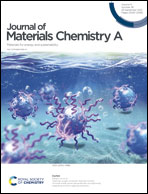High-voltage and intrinsically safe supercapacitors based on a trimethyl phosphate electrolyte†
Abstract
Supercapacitors exhibit excellent power density and durability due to their high ionic conductivity and the electrochemical stability of nitrile or carbonate-based electrolytes. However, these commonly used electrolytes have inherent risks due to the high flammability of organic solvents. With the widespread use of supercapacitors, such safety problems have aroused great concerns. Although considerable research efforts have been devoted to improve the safety of lithium-ion batteries, research focusing on safe supercapacitor performance is limited. Here a nonflammable organic electrolyte based on trimethyl phosphate (TMP) solvent is proposed for safe operation. The physical and electrochemical characteristics of the TMP-based electrolyte are investigated by self-extinguishing time, ionic conductivity, viscosity, cyclic voltammetry, and charge–discharge measurements. We demonstrate that the TMP-based electrolyte enables dramatic improvements in safety as well as good transport properties and stable charge–discharge cycling for 10 000 cycles at a high working voltage (3.3 V) at both low and high current densities. The TMP electrolyte was found to decompose and form a film on the electrode surface preventing further electrolyte decomposition. This helps to widen the electrochemical stability window of supercapacitors, realizing high energy and power by increasing the upper voltage. Therefore, the electrolyte system reported here is a promising candidate for safe and performant supercapacitors in large-scale energy storage applications.



 Please wait while we load your content...
Please wait while we load your content...